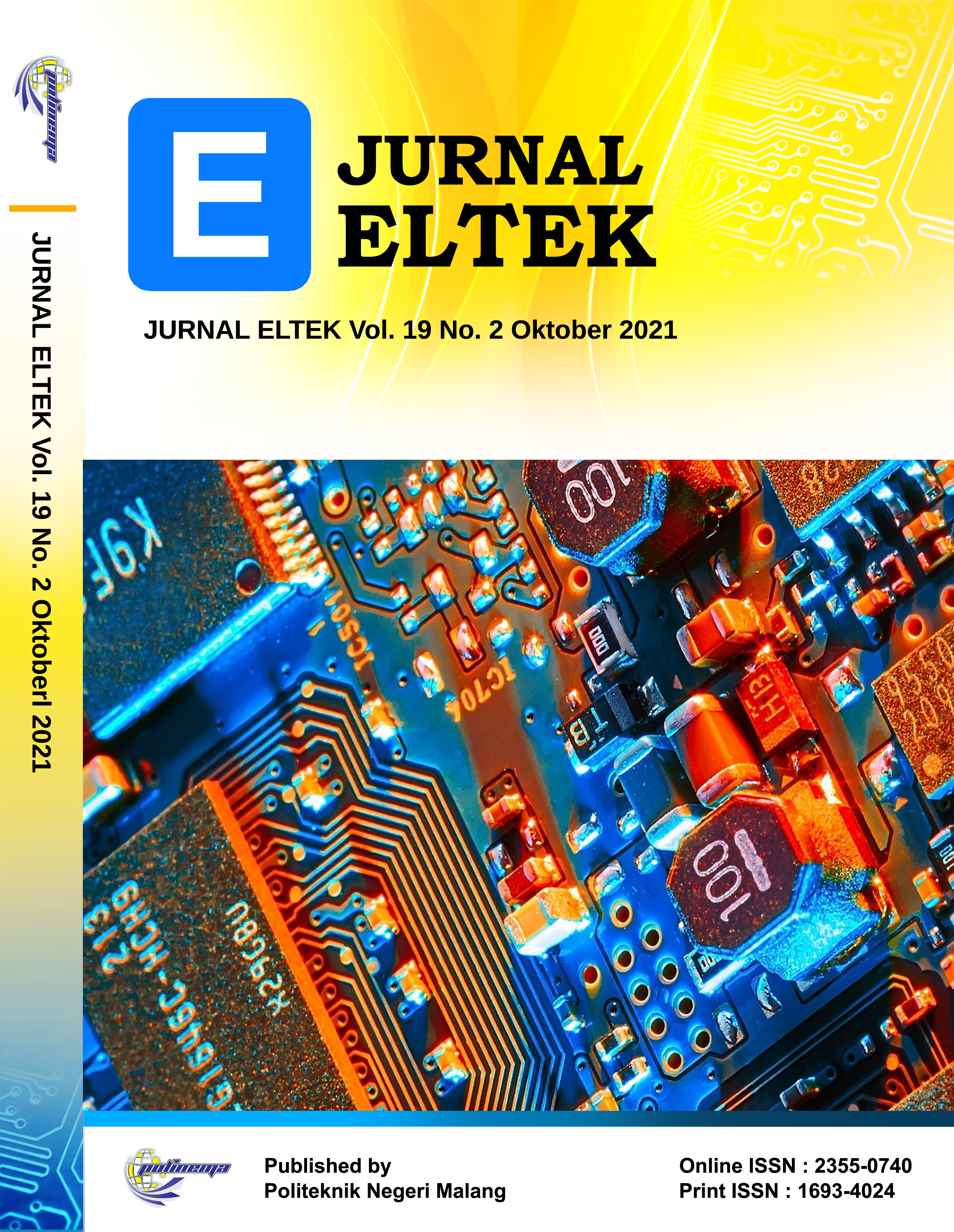Konverter berbasis SEPIC pada modul photovoltaik yang terintegrasi dengan inverter 1 fasa
DOI:
https://doi.org/10.33795/eltek.v19i2.323Keywords:
Photovoltaik, Perturbation Observer, SEPICAbstract
Sistem pembangkit listrik saat ini telah menarik banyak perhatian baik dari kalangan akademik maupun industri. Hal ini disebabkan karena keuntungan yang ditawarkan, antara lain bersih, dapat merubah menjadi listrik secara langsung, dan tidak menyebabkan polusi. Namun, karena masih adanya ketergantungan terhadap kondisi iklim, demikian seperti irradiant maupun suhu, maka daya dari modul photovoltaik ini perlu dimaksimalkan. Terkait dengan hal ini, paper ini menghadirkan suatu metode untuk melacak daya maksimum dari modul photovoltaik berbasis pada metode perturbation observer yang dimodifikasi. Metode pelacakan ini dibuat untuk menghasilkan modulasi lebar pulsa dengan frekuensi 62.5 KHz yang berfungsi untuk mengatur konverter berbasis SEPIC dengan menerima tegangan masukan dari modul PV serta menghasilkan tegangan keluaran yang dapat digunakan untuk mengisi baterai (accu) yang dapat diintegrasikan untuk menghasilkan tegangan AC melalui inverter. Penggunaan SEPIC sebagai pengkondisi sinyal ini karena memiliki keuntungan dimana tegangan keluaran yang dihasilkan tidak dibalik, seperti pada rangkaian konverter buck – boost. Selanjutnya, pemanfaatan metode perturbation observer yang telah dimodifikasi dan diintegrasikan dengan konverter SEPIC menunjukkan kinerja yang memuaskan. Selain itu, sistem yang diajukan hanya memanfaatkan sensor tunggal sebagai masukan dari kontroller.
ABSTRACT
The current power generation system has attracted a lot of attention from both academia and industry. This is due to the advantages offered, including being clean, being able to convert into electricity directly, and not causing pollution. However, because there is still dependence on climatic conditions, such as irradiant and temperature, the power from this photovoltaic module needs to be maximized. Related to this, this paper presents a method to track the maximum power of a photovoltaic module based on a modified perturbation observer method. This tracking method is made to produce pulse width modulation with a frequency of 62.5 KHz which functions to regulate the SEPIC-based converter by receiving input voltage from the PV module and producing an output voltage that can be used to charge the battery (accu) which can be integrated to produce AC voltage through the inverter. The use of SEPIC as a signal conditioner has the advantage that the resulting output voltage is not reversed, as in the buck-boost converter circuit. Furthermore, the use of the modified perturbation observer method integrated with the SEPIC converter showed satisfactory performance. In addition, the proposed system only utilizes a single sensor as input from the controller
References
S. Mekhilef, R. Saidur, and A. Safari, A Review on Solar Energy Use in Industries, Renew. Sustein. Energy Rev., vol. 15, 2011, pp. 1777 - 1790
V. Salas, E. Olias, A. Barrado, and A. Lazaro, Review of the maximum power point tracking algortihm for stand-alone photovoltaic system, sol. Energy mater. Sol. Celss, vol. 90, 2006, pp. 1555 - 1578
G. Spagnuolo, G. Petrone, S. V. Araujo, C. Cecati, et all, Renewable Energy Operation and Conversion schemes : A Summary of Discussions During the semiminar on Renewable Energy System, IEEE Ind. Electron. Magazines., Mar. 2010, pp. 38 – 51.
Himanshu Sharma, Ahteshamul Haque, Zainul Abdin Jaffery, “An Efficient Solar Energy Harvesting System for Wireless Sensor Nodes ”, 2nd IEEE International Conference on Power Electronics, Intelligent Control and Energy Systems (ICPEICES), 2018
L. M. Wheeler, D. T. Moore, R. Ihly, N. J Stanton, E. M. Miller, R. C. Tenent, N. R. Neale, “Switchable photovoltaic windows enabled by reversible photothermal complex disscociation from methylammonium lead iodide, ” Nat. Commun. Vol 8 no.1 , p. 1- 9 , 2017
J Praveen, V VijayaRamaju, “Material for Optimizing Efficiencies of Solar Photovoltaic Panels,” 6th International Conference of Materials Processing and Characterization, 5 – 7 December 2016
Ankita Gaur, G. N. Tiwari, “Performance of Photovoltaic Modules of Different Solar Cells”, Journal of Solar Energy, 2013
Isaac Owusu-Nyarko, Mohamed A. Elgenedy, Khaled Ahmed, “Combined Temprature and Irradiation Effects on the Open Circuit Voltage and Short Circuit Current Constants for Enhancing their Related PVMPPT Algorithms”, IEEE Conference on Power Electronics and Renewable Energy (CPERE), 2019
Shawon Baroi, Pejush Chandra Sarker, Saikot Baroi, “An Improved MPPT Technique – Alternative to Fractional Open Circuit Voltage Method ”, 2nd International Conference on Electrical & Electronic Engineering (ICEEE), 2017
Dhwaj Raverkar, Urvashi Chauhan, Vijander Singh, Asha Rani, “An Improved Fractional Voltage Based MPPT Technique for PV Generation System ”, International Conference on Advances in Computing, Communication & Materials (ICACCM), 2020
Donny Radianto, Gamal M. Dousouky, Masahito Shoyama, MPPT Based on Incremental Conductance – Fuzzy Logic Algorithm for PV System Under Variable Climate Conditions, The 37th, International Conference on Telecommunications Energy, INTELEC 2015, October 18 – 22, 2015, Osaka Japan
Fangrui Liu, Shanzu Duan, Fei Liu, et all, “A Variable Step Size INC MPPT Method for PV System,” IEE Transactions On Industril Electronic, vol. 55., no. 7, July 2008
Qiang Mei, Minwei Shan, et all, “A Novel Improved Variable Step Size Incremental-Resistance MPPT Method for PV Systems, IEEE Trans. On Industrial Electronic, Vol. 58, No. 6, June 2011, pp. 2427 – 2434.
Morcos Metry, Mohammad B. Shadmand, Robert S. Balog, Haitham Abu Rub, “A variable step-size MPPT for sensorless current model predictive control for photovoltaic systems ”, IEEE Energy Conversion Congress and Exposition (ECCE), 2016
Reza Moradpour, Hossein Ardi and Abdolreza Tavakoli, "Design and Implementation of a New SEPICBased High Step-Up DC/DC Converter for Renewable Energy Applications", IEEE Transactions On Industrial Electronics, vol. 65, no. 2, February 2018.
Sin-Woo Lee and Hyun-Lark Do, "Isolated SEPIC DC-DC Converter With Ripple-Free Input Current and Lossless Snubber", IEEE Transactions On Industrial Electronics, vol. 65, no. 2, February 2018.
Mriduwani Verma; S. Shiv Kumar, “Hardware Design of SEPIC Converter and its Analysis”, International Conference on Current Trends towards Converging Technologies (ICCTCT), 2018
Downloads
Published
How to Cite
Issue
Section
License
Copyright (c) 2021 Donny Radianto, Herwandi Herwandi, Yulianto Yulianto

This work is licensed under a Creative Commons Attribution-ShareAlike 4.0 International License.







